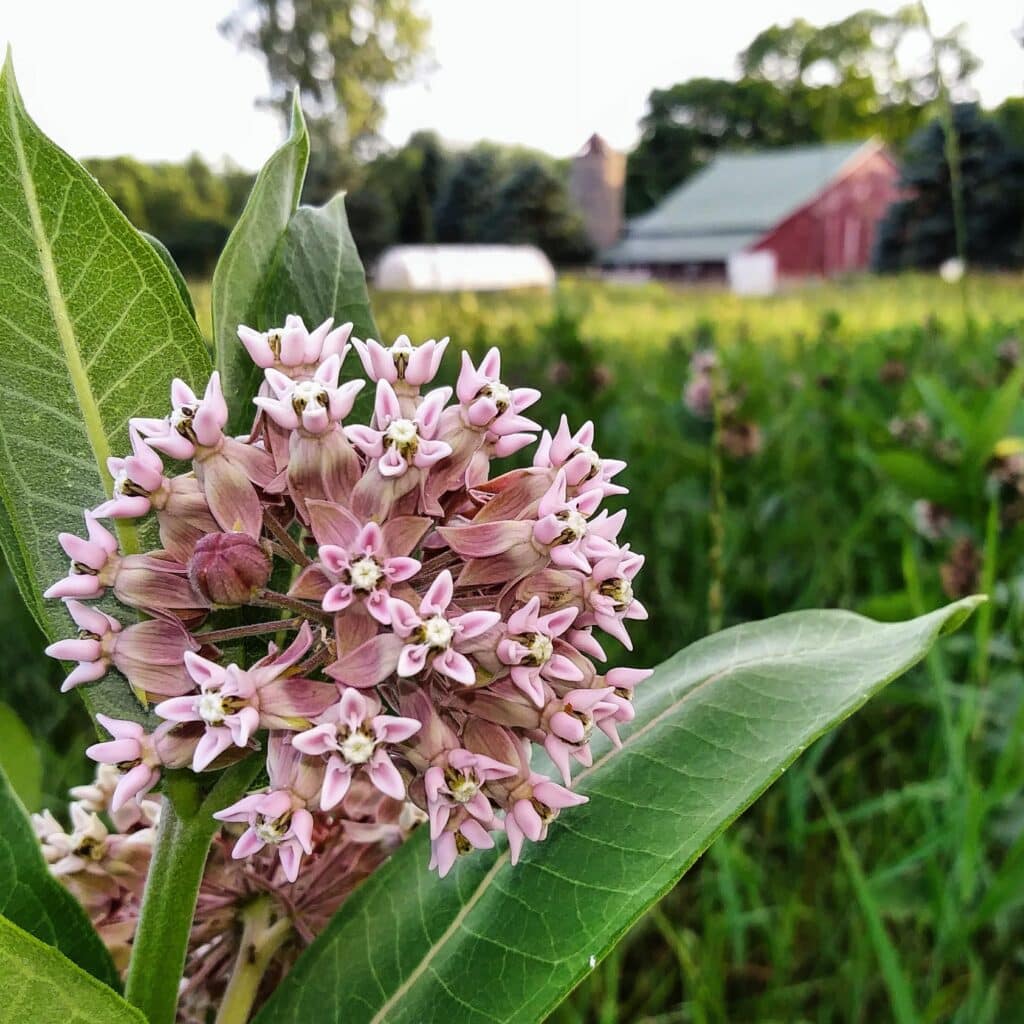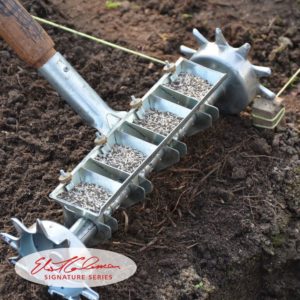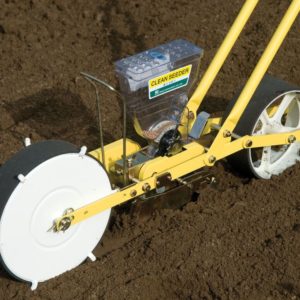When it comes to getting seeds in the ground efficiently, no tool compares to a seeder. This low-tech gadget comes in a variety of sizes and designs, ensuring that there’s an option available for growers at almost every scale. Here are our top picks.

Why use a seeder?
Most of the garden seeders discussed here are classified as walk-behind planters. They typically have a wheel in front that drives a hollow, wedge-shaped structure forward that opens up a furrow in the soil.
A closing device then drops seeds at a pre-set spacing into the ditch, and then a final wheel in the back pulls the soil back over the seed to cover it. In this way, you can plant entire garden beds merely by pushing the seeder through them.
While it’s possible to achieve the same results through hand planting, there are plenty of reasons to consider investing in a garden seeder.
Keeps you upright
Those who grow a large garden or maintain a small farm know the back pain that comes with the industry. Any tool that keeps you upright is worth investing in, as it can exponentially increase your endurance for outdoor work. Seeders prevent you from bending over while planting, which will make a significant difference in your stamina.
More even spacing
Tiny seeds are difficult to space, and hand planting often doubles your work because you need to go back through the beds later to thin out the excess. Using a garden seeder allows for more even spacing so that you both waste less seed and save yourself time in the long run.
Easily adjustable
Most seeders come with a variety of seed plates designed to fit different sized seeds with varying spacing requirements. This means that you can often use the same seeder for everything from carrot seeds to corn without you having to purchase or master multiple pieces of equipment.
Saves time
Try shuffling through the soil on your hands and knees, painstakingly placing a single beet seed every three inches. Now complete the same task with a garden seeder, and you’ll realize that it takes a fraction of the time.
True, it can take a while to change out seed plates and get your seeder ready to go, but once the device is set up, you can seed long rows with ease. Some seeders even include options for planting multiple rows at once to speed up production further.
Our top picks
An abundance of choice leads to problems, though—how can you know which seeder is best for your needs? Let’s dive into our top picks.

Hoss Garden Seeder (Overall Winner)
Highlights: The Hoss Garden Seeder offers simplicity for seeding with high-quality construction and rugged functionality.
Price: $299
The Hoss Garden Seeder is a USA-made planting device that makes no apologies for its ultra-durable construction. It’s crafted with Amish-crafted hardwood handles that are constructed without power tools and left untreated (no potentially toxic preservatives). The seeder also contains steel wheels, a powder-coated steel frame, and a heavy-duty drag chain that covers your planted seeds immediately.
The Hoss seeder relies on seed plates that lay flat in the seed hopper, which ensures accurate spacing and minimal waste, and the rugged wheel design makes this seeder capable of traversing most terrains. If your soil is less than smooth, that’s a significant advantage.
Your purchase comes with six seed plates that are capable of covering most varieties from tiny mustard seeds to squash and pumpkins. At least seven more plates are available to expand your options.
Some might not love the Hoss Seeder’s hopper design, as it consists of a small open container. Not only will it require frequent refilling, but tip the seeder, and your seeds will spill. However, this does mean that switching out seed varieties is a simple process.
Another advantage of the Hoss Seeder is its basic construction. If you consider yourself handy, there’s a good chance that you’ll be able to fix it yourself if something goes wrong.

Four-Row Pinpoint Seeder
Highlights: This ultra-simple seeder is perfect for planting in tight spaces, but don’t expect to get far using it for field crops.
Price: $259
Exclusively offered by Johnny’s Selected Seeds, this Four-Row Pinpoint Seeder is designed for dense plantings, specifically in raised beds or a greenhouse setup. Esteemed organic gardener Eliot Coleman influenced the design, and it boasts a simple construction that requires minimal configuration.
The Four-Row Seeder’s minimalist design makes it easy to maneuver in tight spaces, and the steel hoppers are simple to fill and empty, meaning that you can switch between varieties in minutes. This seeder is put to best use when planting salads and brassica mixes, though some find success using it for slightly larger greens like spinach.
However, simple construction also leads to limitations. You can’t adjust this seeder’s spacing beyond the pre-set one inch, and the small hoppers drop seeds most evenly when they are almost full. This means you might need to take frequent refill breaks, even when seeding small areas. Likewise, it requires ultra-fine soil to seed adequately and will quickly get jammed on weeds and rocks.
From a construction standpoint, the entire seeder is made from high-quality steel and a hardwood handle. Minimal moving parts also mean it’s less likely to break down.

Jang JP Seeder Series
Highlights: The Jang Seeder is the first choice for many organic farmers, thanks to its planting versatility. However, some might find it touchy and difficult to set up.
Price: $440+ (depending on accessories)
Considered by many to be the gold standard of organic farm seeders, the Jang JP Seeder series is best suited for small to medium-sized seeds, though it can be modified to handle any size. Jang also sells a range of accessories that make it possible to scale up your operation. These include a tractor-mounted seeder and a multi-row seeder.
What sets the Jang apart is its reliability and versatility. So long as you pair the correct size roller for the seed you’re sowing, you can expect high accuracy, better germination rates, and a low chance that your plants will require thinning.
You can set the Jang for spacing between 0.5” and 20”, depending on the interchangeable gear, and it’s also possible to adjust the planting depth for extra control for every variety. However, it can be a pain to switch out the adjustable seeding plates, which makes this seeder most efficient when you’re planting a lot of the same variety at once.
Many appreciate the Jang’s transparent hopper, which lets you see precisely when you need to reload the seeds. This seeder’s rugged design also makes it more suitable than other options for rocky or uneven soil, though the machine itself might be too heavy for some users to handle.
Most of the Jang’s construction is high-quality steel. Even the adjustable sprockets are made from an anti-abrasive plastic, as opposed to thinner plastic like the EarthWay. The part of the seeder most likely to break is the clear plastic hopper, but this is a low impact part that shouldn’t break down with regular use. In other words—buy this seeder once, and it should last a lifetime.
In summary
While most garden seeders have their advantages, choosing the right one for your needs comes down to knowing your priorities and investing in quality. Look for models scaled to your space, and consider whether you prefer to have a lot of options for adjustments, or whether you want a seeder you can start using immediately with minimal fussing.
No matter what model you choose, we recommend prioritizing quality construction. You want your seeder to last for seasons to come. This is important both from an environmental standpoint and so that you aren’t left in a lurch the middle of the summer without a reliable way to get your seeds in the ground.